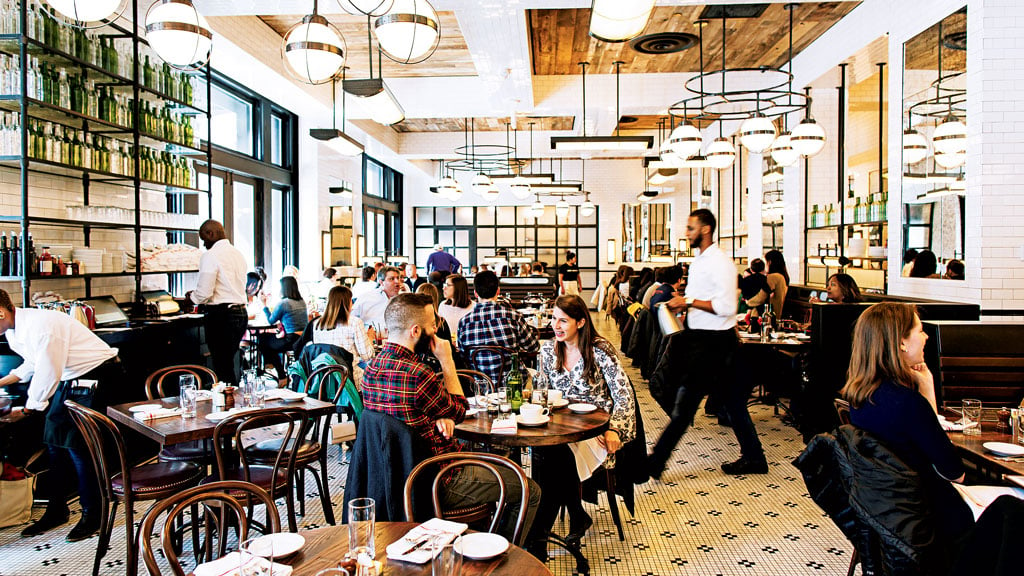In the wake of the Washington Capitals and Wizards announcing plans to leave Capital One Arena in downtown DC for a new facility in Alexandria, Mayor Muriel Bowser recently created a new Gallery Place/Chinatown Task Force. Charged with re-envisioning the two city blocks surrounding the arena, the task force’s executive committee includes former mayors Anthony Williams and Adrian Fenty and celebrity chef José Andrés. Bowser has also encouraged interested DC residents to collaborate with the mayor’s office and share their visions for the future of Gallery Place/Chinatown.
“We’ve been successful in creating new and dynamic neighborhoods across DC by putting old spaces to new uses,” Bowser said in a statement. “We’ve done this before—at Union Market, at Navy Yard, at the Wharf, at City Center. This Task Force will make it happen again.”
Billed with creating an “immediate activation plan” for the Gallery Place/Chinatown neighborhood—as well as a longer-term vision and investment plan—the task force is “going to be fast,” according to Bowser. But will it produce positive results? If the past is any indicator of future progress, don’t break out the champagne just yet. Here’s a look at previous city government task forces—and what they did or didn’t accomplish in DC:
Homicide Prevention
Issue: In 2016, there were 135 homicides in the city, according to the DC police.
Task force: As part of legislation meant to reduce violence, the DC Council that year created the Comprehensive Homicide Elimination Strategy Task Force—a 20-person group made up of ten mayoral appointees and ten council appointees from various nonprofit and victim services organizations, businesses, and government agencies. Members included David Bowers, the founder of the group No Murders DC and Natalia Otero, the founder and executive director of DC SAFE.
Results: The group’s inaugural meeting took place two years after the legislation was passed and the task force had only five meetings publicly accounted for with listed agendas, according to DCist. The task force did produce a detailed strategy for violence reduction that urged Bowser to create an Office of Homicide Elimination, Violence Prevention, and Community Empowerment in the Office of the City Administrator. However, when the proposal was presented to lawmakers in 2020 it did not produce any direct outcomes. Meanwhile, DC’s murder rate reached a 16-year high in 2021. Last year was even deadlier, with 274 homicides—the highest number in more than two decades, and roughly a 35 percent increase from 2022.
Controversial Public Monuments
Issue: Of the 500 US monuments listed on the National Monument Audit, the top 50 memorialized individuals include 27 slave owners such as Robert E. Lee. Likewise, one third of the Capitol building’s 400-some artworks celebrate slave owners and Confederates. DC also has similar monuments—for example, there’s a statue downtown of John Marshall, who owned hundreds of enslaved people.
Task force: In 2020, protests over the murder of George Floyd lasted from May to June in DC, setting the stage for a deeper examination into the systemic racism and oppression that African Americans face. Bowser commissioned the District of Columbia Facilities and Commemorative Expressions (DCFACES) task force, which began meeting that July and was charged with qualifying public-works dedications as unsavory using the criteria of being “an enslaver of people,” belonging to “a supremacist organization active in the suppression of people of color,” and three other key conditions. Ultimately, the committee recommended renaming or removing 49 different government-owned city spaces and cited figures such as George Washington, Alexander Graham Bell, and Thomas Jefferson as problematic.
Results: The effort to rename, remove, and revamp public statues seems to have largely dissipated following tremendous backlash. For example, there are currently three monuments and a school dedicated to Benjamin Franklin, who was cited as controversial in the 24-page DCFACES executive summary due to the fact that he owned slaves and benefitted from the institution of slavery. In addition, the task force’s most polarizing recommendation—for federal authorities to “remove, relocate, or contextualize” eight federal monuments, including the iconic Washington Monument—was deleted the same day it was published, according to the Washington Post.
Converting Offices to Affordable Housing
Issue: In June 2018, DC homes reached a median sales price of $603,375, per the District of Columbia Association of Realtors. The rising prices of homes and the ongoing issue with homelessness—1 in every 100 DC residents experienced housing insecurity in 2018—were two key elements in the housing affordability crisis.
Task force: The Office-to-Affordable Housing Task Force was established to ascertain the pros and cons of transitioning empty commercial office buildings into affordable residential housing units. Chaired by the the Office of the Deputy Mayor for Planning and Economic Development, the task force had five public meetings and one presentation, and produced an August 2019 report which recommended providing zoning incentives, funding feasibility studies, and directly subsidizing office to affordable housing conversions.
Results: From 2020 to 2021, 1,147 office spaces were repurposed into new apartments in DC, which was the most office-to-rental conversions in the country during this period, according to data from real estate analysis group Yardi Matrix. The Housing in Downtown Tax Abatement program was signed into law in July 2022, and allows builders who are converting commercial spaces into housing units to qualify for a 20-year tax break as long as a minimum of 15 percent of the units are affordable and meet the requirements of the Inclusionary Zoning Program. However, whether the task force had a significant impact on these measures is hard to say, given that the pandemic and resulting shift in work-from-home policies in both the public and private sectors have created greater interest in converting empty offices into residential units.
Boosting Student Attendance
Issue: From 2018 to 2019, about 27 percent of DC students were chronically absent and missed 10 percent or more of the school year, which in turn has been connected to dropping out of high school altogether.
Task force: The truancy task force–which was created in 2015 to address truancy and chronic absenteeism–was renamed the Every Day Counts! Taskforce in July 2017. The Every Day Counts! Taskforce took on a new moniker to better appeal to public audiences and to expansively focus on all forms of absenteeism, per its meeting notes. As of January 2018, 14 DC schools received almost 150 incentives such as gift cards, pancake breakfasts, and movie nights, attendance was discussed with 23 schools, and over 2,200 students and community members signed attendance pledges.
Results: Whatever good the task force was able to accomplish before 2020 was wiped out by COVID. In meeting notes from March 2023, the task force reported that at the end of 2022, chronic absenteeism was at 41.1 percent and that attendance had not yet rebounded to pre-pandemic levels. (The Office of the State Superintendent of Education reports a similarly bleak picture, with chronic absenteeism at 43 percent in the 2022-23 school year).
Reducing Crime in Nightlife Hot Spots
Issue: In 2022, crime in popular after-hours spots like the U Street Corridor was 261 percent higher than the national average.
Task force: That June, Bowser launched the Multiagency Nightlife Task Force, which aimed to curb violent crime in three popular nightlife areas: U Street, Northwest, Connecticut Avenue, Northwest, and H Street, Northeast. The task force set out to reduce crime for business owners, residents, and community members, uphold traffic and parking regulations, seize illegal ATV’s, and discover discrepancies in staffing and resources in the designated areas.
Results: The task force documented a 28 percent decrease in total crime in the U Street Corridor, a 20 percent decrease in total crime in the H Street Corridor, and a 616 percent decrease in total crime in the Connecticut Avenue Corridor between June and December 2022. However, while some local merchants commended the task force’s results—less ATVs and gunfire—they also noted that the street closures that have been part of the task force’s operations can limit access to businesses and increase customer anxiety.



















